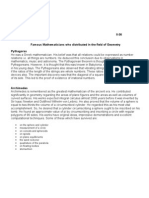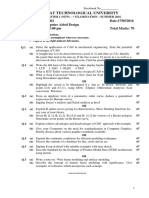Pythagorean Theorem
Pythagorean Theorem
Uploaded by
akiyama_ma83Copyright:
Available Formats
Pythagorean Theorem
Pythagorean Theorem
Uploaded by
akiyama_ma83Original Description:
Copyright
Available Formats
Share this document
Did you find this document useful?
Is this content inappropriate?
Copyright:
Available Formats
Pythagorean Theorem
Pythagorean Theorem
Uploaded by
akiyama_ma83Copyright:
Available Formats
Pythagorean theorem
From Wikipedia, the free encyclopedia
See also: Pythagorean trigonometric identity
Pythagorean theorem
The sum of the areas of the two squares on the legs (a and b) equals the area of the square on the hypotenuse (c).
Geometry
Projecting a sphere to a plane.
History
Branches
Euclidean
Spherical
Non-Euclidean
Elliptic
Hyperbolic
Synthetic
Analytic
Algebraic
Riemannian
Differential
Symplectic
Finite
Projective
Concepts
Features
Dimension
Compass-and-straightedge constructions
Angle
Curve
Diagonal
Parallel
Perpendicular
Vertex
Congruence
Similarity
Symmetry
Zero / One-dimensional
Point
Line
segment
ray
Length
Two-dimensional
Plane
Area
Polygon
Triangle
Altitude
Hypotenuse
Pythagorean theorem
Parallelogram
Square
Rectangle
Rhombus
Rhomboid
Quadrilateral
Trapezoid
Kite
Circle
Diameter
Circumference
Area
Three-dimensional
Volume
Cube
cuboid
Cylinder
Pyramid
Sphere
Four / other-dimensional
Tesseract
Geometers
by name
Aida
Aryabhata
Ahmes
Alhazen
Apollonius
Archimedes
Atiyah
Baudhayana
Bolyai
Brahmagupta
Cartan
Descartes
Euclid
Euler
Gauss
Gromov
Hilbert
Jyes t hadeva
Ktyyana
Khayym
Klein
Lobachevsky
Manava
Minkowski
Minggatu
Pascal
Pythagoras
Parameshvara
Poincar
Riemann
Sakabe
Sijzi
al-Tusi
Veblen
Virasena
Yang Hui
al-Yasamin
Zhang
by period
BCE
Ahmes
Baudhayana
Manava
Pythagoras
Euclid
Archimedes
Apollonius
11400s
Zhang
Ktyyana
Aryabhata
Brahmagupta
Virasena
Alhazen
Sijzi
Khayym
al-Yasamin
al-Tusi
Yang Hui
Parameshvara
1400s1700s
Jyes t hadeva
Descartes
Pascal
Minggatu
Euler
Sakabe
Aida
1700s1900s
Gauss
Lobachevsky
Bolyai
Riemann
Klein
Poincar
Hilbert
Minkowski
Cartan
Veblen
Present day
Atiyah
Gromov
In mathematics, the Pythagorean theorem, also known as Pythagoras's theorem, is a relation
in Euclidean geometry among the three sides of a right triangle. It states that the square of
the hypotenuse (the side opposite the right angle) is equal to the sum of the squares of the other two
sides. The theorem can be written as an equation relating the lengths of the sides a, b and c, often
called the "Pythagorean equation":[1]
where c represents the length of the hypotenuse and a and b the lengths of the triangle's other
two sides.
Although it is often argued that knowledge of the theorem predates him, [2] the theorem is named
after the ancient Greekmathematician Pythagoras (c. 570 c. 495 BC) as it is he who, by
tradition, is credited with its first recorded proof.[3][4][5] There is some evidence that Babylonian
mathematicians understood the formula, although little of it indicates an application within a
mathematical framework.[6][7] Mesopotamian, Indian and Chinese mathematicians all discovered
the theorem independently and, in some cases, provided proofs for special cases.
The theorem has been given numerous proofs possibly the most for any mathematical
theorem. They are very diverse, including both geometric proofs and algebraic proofs, with some
dating back thousands of years. The theorem can be generalized in various ways, including
higher-dimensional spaces, to spaces that are not Euclidean, to objects that are not right
triangles, and indeed, to objects that are not triangles at all, but n-dimensional solids. The
Pythagorean theorem has attracted interest outside mathematics as a symbol of mathematical
abstruseness, mystique, or intellectual power; popular references in literature, plays, musicals,
songs, stamps and cartoons abound.
Contents
1Pythagorean proof
2Other forms of the theorem
3Other proofs of the theorem
3.1Proof using similar triangles
3.2Euclid's proof
3.3Proofs by dissection and rearrangement
3.4Einstein's proof by dissection without rearrangement
3.5Algebraic proofs
3.6Proof using differentials
4Converse
5Consequences and uses of the theorem
o
5.1Pythagorean triples
5.2Incommensurable lengths
5.3Complex numbers
5.4Euclidean distance in various coordinate systems
5.5Pythagorean trigonometric identity
5.6Relation to the cross product
6Generalizations
o
6.1Similar figures on the three sides
6.2Law of cosines
6.3Arbitrary triangle
6.4General triangles using parallelograms
6.5Solid geometry
6.6Inner product spaces
6.7Sets of m-dimensional objects in n-dimensional space
6.7.1Applied to sets containing a single object
6.7.2Applied to sets containing multiple objects
6.7.3Applied in any number of dimensions
6.8Non-Euclidean geometry
6.8.1Spherical geometry
6.8.2Hyperbolic geometry
6.9Differential geometry
7History
8In popular culture
9See also
10Notes
11References
12External links
Pythagorean proof
The Pythagorean proof (click to view animation)
The Pythagorean Theorem was known long before
You might also like
- Star 1x01 - PilotDocument48 pagesStar 1x01 - PilotVera GritNo ratings yet
- 29 Aurtta105Document19 pages29 Aurtta105khattarbhoomiNo ratings yet
- The Origin of Angle-Geometry - Solomon GandzDocument31 pagesThe Origin of Angle-Geometry - Solomon GandzGènny GìnnyNo ratings yet
- A History of Greek Mathematics, Volume II: From Aristarchus to DiophantusFrom EverandA History of Greek Mathematics, Volume II: From Aristarchus to DiophantusRating: 4 out of 5 stars4/5 (1)
- REMS Katalog 2013 GBRoP - Stand 2013-03-07Document224 pagesREMS Katalog 2013 GBRoP - Stand 2013-03-07Stelian Olaru100% (1)
- Psychrometric Data PDFDocument9 pagesPsychrometric Data PDFWolveringClaydermanNo ratings yet
- Pythagorean Expectation: This Article Is About Classical Geometry. For The Baseball Term, SeeDocument2 pagesPythagorean Expectation: This Article Is About Classical Geometry. For The Baseball Term, SeeSURYA SNo ratings yet
- Analytical Observations: Chapter - ViDocument30 pagesAnalytical Observations: Chapter - VisujupsNo ratings yet
- Pythagorean TheoremDocument23 pagesPythagorean Theoremlutfu saribulutNo ratings yet
- Of Miletus, A Mathematician Living in The 6th Century BCE. He IsDocument10 pagesOf Miletus, A Mathematician Living in The 6th Century BCE. He IsmoninaNo ratings yet
- Phase TransitionDocument31 pagesPhase TransitionSoloproNo ratings yet
- Unit 1Document10 pagesUnit 1Agresia SabubunNo ratings yet
- Mathematics Euclidean Geometry Right Triangle Hypotenuse Right Angle Other Two Sides Theorem EquationDocument1 pageMathematics Euclidean Geometry Right Triangle Hypotenuse Right Angle Other Two Sides Theorem EquationAna May BanielNo ratings yet
- Gayta, Geliza T. II-36Document2 pagesGayta, Geliza T. II-36Evelyn Tabernero JosephNo ratings yet
- Herodianic - Numerals (History of Math)Document38 pagesHerodianic - Numerals (History of Math)Elle Villanueva VlogNo ratings yet
- Pythagorean Theorem PDFDocument24 pagesPythagorean Theorem PDFC Subrahmanya KarthikNo ratings yet
- Euclid and Archimedes - History and Philosophy of MathDocument50 pagesEuclid and Archimedes - History and Philosophy of MathJennifer Grace CastroNo ratings yet
- Pembuktian PythagorasDocument93 pagesPembuktian PythagorasSesi WinarniNo ratings yet
- Pythagoran Theorm Final PaperDocument2 pagesPythagoran Theorm Final PaperGuy SabbanNo ratings yet
- 02 GeometryDocument5 pages02 GeometryhongnhNo ratings yet
- 1 AakzDocument14 pages1 Aakzadehcm2021tsiNo ratings yet
- (1928) - Cajori, F. Ciruelo On The Names - Arithmetical - and - Geometrical - Proportions and ProgressionsDocument5 pages(1928) - Cajori, F. Ciruelo On The Names - Arithmetical - and - Geometrical - Proportions and ProgressionsnayibeNo ratings yet
- Pythagoras TheoremDocument29 pagesPythagoras TheoremSahil Jindal0% (1)
- Solid Mensuration: Mr. Mark Jave C. Gualberto, RmeDocument49 pagesSolid Mensuration: Mr. Mark Jave C. Gualberto, RmeRoi Emmanuel PadilloNo ratings yet
- Solid Mensuration Module 1Document9 pagesSolid Mensuration Module 1Azha Clarice Villanueva100% (2)
- Chapter 1 Classical Euclidean GeometryDocument33 pagesChapter 1 Classical Euclidean Geometryannjerniel2No ratings yet
- PYTHAGORAS THEOREM Project (Simple Holiday Package)Document8 pagesPYTHAGORAS THEOREM Project (Simple Holiday Package)helloandhaiNo ratings yet
- Greek MathematicsDocument39 pagesGreek MathematicsAdc ClamorNo ratings yet
- Pythagorean Information PDFDocument28 pagesPythagorean Information PDFPhani KumarNo ratings yet
- Objective:: Study of Various Aspects of Pythagoras TheoremDocument8 pagesObjective:: Study of Various Aspects of Pythagoras TheoremPriyanka PilaniaNo ratings yet
- Geometry History 2Document11 pagesGeometry History 2Moises ToledoNo ratings yet
- Pythagoras and The Pythagorean Theorem: Grade 8-9 Lesson by Lindsay KallishDocument14 pagesPythagoras and The Pythagorean Theorem: Grade 8-9 Lesson by Lindsay KallishgraalhackerNo ratings yet
- Pythagoras (Mathematician) by Chatkamon Chaiman Section 1 ID: A14120152 Room 1-314 Major Airline Business To Aj YvesDocument10 pagesPythagoras (Mathematician) by Chatkamon Chaiman Section 1 ID: A14120152 Room 1-314 Major Airline Business To Aj YvesAnonymous OiwZT6dNo ratings yet
- PythagorasDocument14 pagesPythagorasJaymark JaretaNo ratings yet
- TrigonometryDocument8 pagesTrigonometryvaghdrashtiNo ratings yet
- A Brief History of GeometryDocument29 pagesA Brief History of GeometryDie A Muslimah100% (1)
- Phytagorean TheoremDocument101 pagesPhytagorean TheoremJohn Esteves GarciaNo ratings yet
- Euclidean Geometry: Big IdeasDocument9 pagesEuclidean Geometry: Big IdeasLauren RussellNo ratings yet
- Golden Golden: Ratio and RectangleDocument25 pagesGolden Golden: Ratio and RectangleCherie AshishNo ratings yet
- Pythagorean Theorem: 5000 B.C. and Other Philosophical FantasiesDocument91 pagesPythagorean Theorem: 5000 B.C. and Other Philosophical FantasiesDini Putri UtamiNo ratings yet
- Eudoxus of CnidusDocument3 pagesEudoxus of CnidusBridget Anne BenitezNo ratings yet
- The School of Athens: (Raphael) 1510 - 11Document28 pagesThe School of Athens: (Raphael) 1510 - 11stretfordhighNo ratings yet
- GeometryDocument37 pagesGeometryKasie Sobremisana100% (1)
- The Converse of Pythagoras Theorem IsDocument5 pagesThe Converse of Pythagoras Theorem IsAlbert FrancisNo ratings yet
- The Origine of GeometryDocument4 pagesThe Origine of GeometryShiela mae FloresNo ratings yet
- History of TrigDocument19 pagesHistory of TrigacqacqNo ratings yet
- Iamblichus TheologyarithmeticDocument60 pagesIamblichus Theologyarithmeticinder3No ratings yet
- TrigonoDocument6 pagesTrigonoMo MontannaroNo ratings yet
- History of Math TreshalynDocument54 pagesHistory of Math Treshalynartlove banairaNo ratings yet
- Pythagorean Theorem ProofsDocument106 pagesPythagorean Theorem ProofsCharles SetserNo ratings yet
- Real Analysis-1 Group 4,5,6Document45 pagesReal Analysis-1 Group 4,5,6Attiqa KanwalNo ratings yet
- Script Materi 7 HismathDocument3 pagesScript Materi 7 HismathPITTAULI AMBARITANo ratings yet
- Pythagorean Theorem PDFDocument106 pagesPythagorean Theorem PDFTru ManNo ratings yet
- The Beginning of Greek MathematicsDocument102 pagesThe Beginning of Greek MathematicsRene Jay-ar Morante SegundoNo ratings yet
- Greek MathDocument42 pagesGreek MathLau Yong HuiNo ratings yet
- Safari - Dec 31, 2023 at 5:07 AMDocument1 pageSafari - Dec 31, 2023 at 5:07 AMsyansyncNo ratings yet
- MathemathicsDocument4 pagesMathemathicsJosué ArmasNo ratings yet
- The Rise, Fall, and Possible Transfiguration of Triangle Geometry: A Mini-History Author(s) : Philip J. DavisDocument12 pagesThe Rise, Fall, and Possible Transfiguration of Triangle Geometry: A Mini-History Author(s) : Philip J. DavisEric TsieNo ratings yet
- Four-Dimensional Space - Wikipedia, The Free Encyclopedia PDFDocument14 pagesFour-Dimensional Space - Wikipedia, The Free Encyclopedia PDFalphatauri13No ratings yet
- Aravind ADocument16 pagesAravind ABabu .D .R AlluNo ratings yet
- The History of Trigonometry and of Trigonometric Functions May Span Nearly 4Document10 pagesThe History of Trigonometry and of Trigonometric Functions May Span Nearly 4chadlow100% (2)
- CreditDocument51 pagesCreditVanessa BiscoNo ratings yet
- Four Dimensional Space Wikipedia The Free Encyclopedia PDFDocument14 pagesFour Dimensional Space Wikipedia The Free Encyclopedia PDFZarabottaNo ratings yet
- Consumers Data ProvidersDocument2 pagesConsumers Data Providersakiyama_ma83No ratings yet
- 3 Secrets of Successful CompaniesDocument7 pages3 Secrets of Successful Companiesakiyama_ma83No ratings yet
- Visual Basic Is A Third-Generation Event-Driven Programming LanguageDocument4 pagesVisual Basic Is A Third-Generation Event-Driven Programming Languageakiyama_ma83No ratings yet
- The Six Trigonometric Functions and Reciprocals FunctionsDocument4 pagesThe Six Trigonometric Functions and Reciprocals Functionsakiyama_ma83No ratings yet
- Section 3 Power Train System: Group 1 Structure and OperationDocument18 pagesSection 3 Power Train System: Group 1 Structure and OperationAndré TarginoNo ratings yet
- Background Information On The Theta EbookDocument3 pagesBackground Information On The Theta EbookOmar RafiNo ratings yet
- Sopm - 20!60!02 Finishing MaterialsDocument24 pagesSopm - 20!60!02 Finishing Materialsaviatek.recexNo ratings yet
- 2023-2024 ResumeDocument2 pages2023-2024 Resumeapi-582473853No ratings yet
- Different Advancement in Science and Technology: 1. Semiconductor ChipsDocument5 pagesDifferent Advancement in Science and Technology: 1. Semiconductor ChipsRegiena AnicieteNo ratings yet
- Studio EM WebDocument2 pagesStudio EM WebjohanNo ratings yet
- Ashrae D 90455Document450 pagesAshrae D 90455Alejandro Darlington MirandaNo ratings yet
- Nutrition Throughout The Life CycleDocument87 pagesNutrition Throughout The Life Cyclealsuwaidi5No ratings yet
- BG1 2006Document76 pagesBG1 2006Abraham JyothimonNo ratings yet
- Svetsaren Vol 58 Tandem MIG MAG WeldingDocument2 pagesSvetsaren Vol 58 Tandem MIG MAG WeldinglvcuichanghuaNo ratings yet
- FullerenesDocument411 pagesFullereneslsueyinNo ratings yet
- Senior Two: 1. The Turning Effect of ForcesDocument205 pagesSenior Two: 1. The Turning Effect of ForcesRoni NserekoNo ratings yet
- Design Amba Based Ahb To Apb Bridge Using Verilog HDL: Prarthi Bhatt, Prof..Devang ShahDocument5 pagesDesign Amba Based Ahb To Apb Bridge Using Verilog HDL: Prarthi Bhatt, Prof..Devang ShahPotnuru KarishmaNo ratings yet
- Transition PlanDocument14 pagesTransition Planapi-572616954No ratings yet
- Case Studies For Green InfrastructureDocument45 pagesCase Studies For Green InfrastructureVasu KodagantiNo ratings yet
- Cuisinart Juicer Cje-1000 ManualDocument10 pagesCuisinart Juicer Cje-1000 ManualShawn A. WygantNo ratings yet
- 63mm Multi Purpose NozzleDocument2 pages63mm Multi Purpose NozzleMitul PatelNo ratings yet
- S. No Case No. F.4-Particulars of Post(s) Qualifications For Posts Test Specification Main Topics Part-I Part-IIDocument30 pagesS. No Case No. F.4-Particulars of Post(s) Qualifications For Posts Test Specification Main Topics Part-I Part-IIMansoor AliNo ratings yet
- Pharmaceutical Analysis: Quality Control of PharmaceuticalsDocument40 pagesPharmaceutical Analysis: Quality Control of Pharmaceuticalspiedad luciaNo ratings yet
- CU BoulderDocument33 pagesCU BoulderVedran IbrahimovicNo ratings yet
- Lifting Lug Design - USA Air Force MethodDocument15 pagesLifting Lug Design - USA Air Force MethodOSCARDELTANo ratings yet
- Gujarat Technological UniversityDocument1 pageGujarat Technological UniversityBhavin ChavdaNo ratings yet
- Expirement No 1Document4 pagesExpirement No 1Rajiv KharbandaNo ratings yet
- WarZ Item IDDocument6 pagesWarZ Item IDMarcelo Souza100% (2)
- 9 Hydraulic FracturingDocument45 pages9 Hydraulic FracturingAyoub EL-hamrouniNo ratings yet
- Phy - 101 Mid Term by Vu Topper RMDocument16 pagesPhy - 101 Mid Term by Vu Topper RMhira anwar100% (1)





























































































